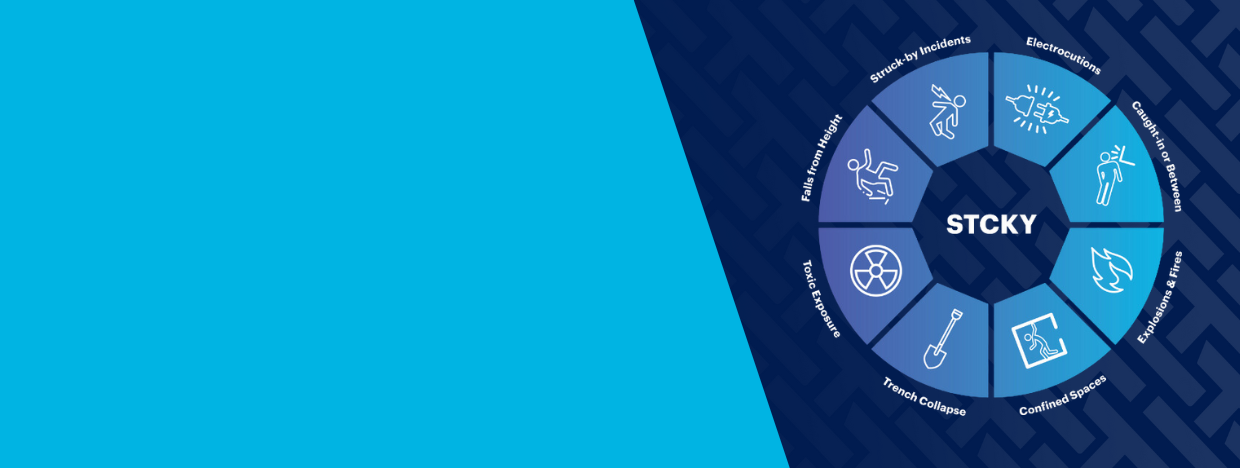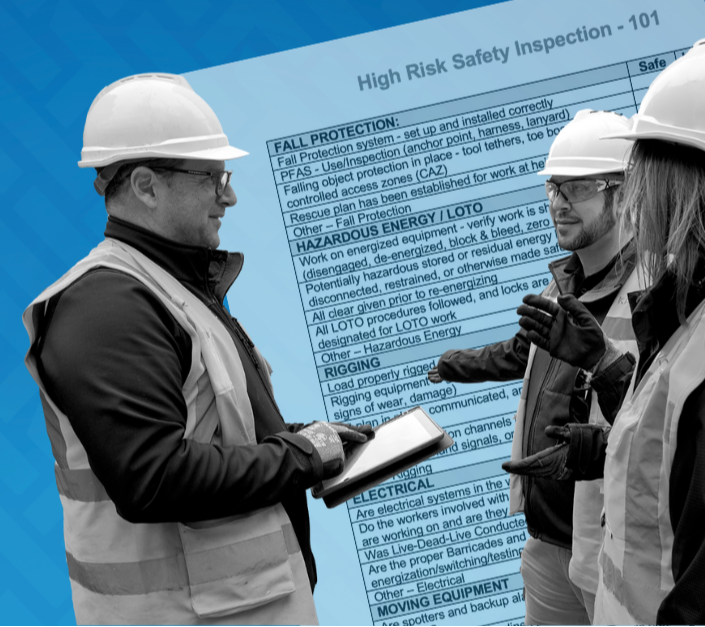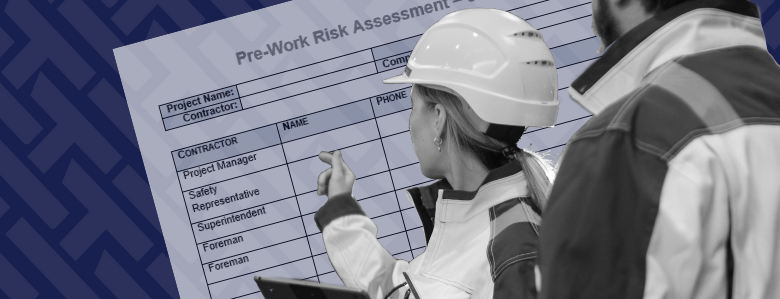What's Inside |
Introduction
Not all risks are created equal. In the high-stakes world of commercial construction, hazards are an ever-present reality. Managing these risks effectively prevents incidents, injuries, and fatalities on your job site.
Increasingly, contractors are prioritizing the most severe construction safety risk and hazards and there are immense benefits of this focused approach.
The most critical dangers—those with the highest potential to cause serious harm—are also called:
-
Stuff That Can Kill You (STCKY)
-
Potential for Serious Injury or Fatality (PSIF)
-
High Risk Activity (HRA)
We’re going to focus on STCKY here following a live event with Reese Fortin, Direct of HSE at Sundt Construction. Reese is acting chairwoman of the AGC Safety Council in Arizona. She is also a founder of Sundt’s industry recognized Stop the STCKY campaign which offers concrete evidence of how a proactive approach to managing high-risk situations on site can benefit you.
The principles also apply to PSIF and HRA, depending on your terminology preferences.
Shifting the focus
“In our United States construction industry, fatalities have increased and that's not acceptable. We need to do something about it,” said Reese during the live event.
Numbers from the Bureau of Labor show the scale of the problem. In the last full year on record:
-
5,486 fatal construction incidents were recorded
-
Fatalities on site increased 5.7%
-
A construction worker died every 96 minutes
How can we bring those numbers down? Proactive management of STCKY hazards using data driven insights holds the key for contractors who are looking for ways to reduce incidents and fatalities on site.
To implement a STCKY program, we need to re-think some of our processes and access to data that supports accountability.
When and why integrate STCKY into your safety program?
“We don't have an infinite number of safety professionals available or superintendents that can be on every job. So, what we need to do is focus our efforts on the projects that have STCKY activities. Identifying those activities upfront helps us really put our resources in the right spots.” — Dylan Hipple, Senior Customer Success Manager at HammerTech.
Understanding and integrating STCKY concepts into your planning and daily operations offers the following benefits:
-
Fewer serious incidents
-
Better planning and collaboration
-
Optimized resource allocation
-
Strong reputation for safety
-
Cost savings
Reese illustrates the practical impact of being proactive with STCKY safety planning, saying: “When we start a new project, we have a project safety plan just like any contractor that talks about how we’re going to manage safety on the project. But in that document, we have made sure we've outlined STCKY activities and controls up to a year or more before we even go build the project.
“We're able to allocate resources like money for, say, a buck hoist instead of having personnel carry stuff upstairs, or we're able to put more money in for maybe prefabricating things off site.”
How can you integrate STCKY planning in your company effectively?
Effective processes and access to data will help you integrate STCKY safety concepts from the project planning phase through the entire build process.
Four main focus areas, along with their associated data, offer the greatest potential for limiting high-risk incidents.
-
Pre-construction risk assessment and safety plans – Use historical data from similar packages of work and common construction knowledge to identify activities which can lead to serious incidents. STCKY activities should be identified with associated hazards and controls.
-
Data: Subcontractor submission compliance rates, JHA and safety plan quality through approvals to ensure the STCKY was identified
-
-
Pre-task planning – Daily activity to talk through and question upcoming tasks, identify STCKY activities and plan for potential dangers.
-
Data: Pre-task plan completion rate, hazards identified, reduction in rework
-
-
Inspections and observations – specific STCKY focused site walks using observation and safety software to ascertain whether you are controlling STCKY risks properly.
-
Data: KPIs and number of STCKY inspections complete, negative observations
-
-
Incident investigation – A STCKY analysis following any incident to determine incident numbers and types, any near misses, what injuries and incidents had PSIF and how to stop repeat incidents in future.
-
Data: Incident numbers and types, be able to identify near misses, injuries and incidents that were PSIF
-
STCKY Walks on Site
To show how this could work for you, Reese Fortin takes a deeper dive into what a STCKY walk entails and how it can be integrated on site: “We have a weekly expectation for our operations employees to do at least one STCKY walk with our safety app. For example, I’m going to go and watch these iron workers erect a steel building.
“The app asks a few questions. If the answers are ‘yes’, then we're controlling STCKY and no one's going to get seriously hurt or killed in that activity.
“If the answers are ‘no’, it guides us into a mini analysis on the spot, asking how someone is exposed to STCKY risk? Was the hazard recognized? Do they know what they should have had in place? Did they have the equipment they should have?”
The answers to those questions then allow you to see, understand and fix STCKY risks on your site before it’s too late.
Finally, Reese notes that the key to integrating this type of STCKY planning effectively is to ensure that, “people are held accountable to this, and their bonuses are impacted by it.”
Using technology and data to continuously improve and Stop the STCKY
Data insights help to integrate STCKY into safety programs more effectively. Dedicated construction safety software upgrades your inspections, incident analyses, and pre-task planning, providing you with data to help you stay ahead of these significant risks.
With a safety platform you can:
- See your most common STCKY activities
- Find gaps in training, planning and processes
- Understand exactly what behaviors are creating STCKY situations
Reese explains how this continuous improvement loop works in practice, saying: “We're able to look at the data and educate ourselves on where we should be focusing our time and energy.”

For instance, in the recent live event, she shared how data analysis revealed a recurring issue with improper use of fall protection equipment.
“If people are tying off incorrectly, we can target that with specific training. By analyzing the data, we can identify why we're exposing people to STCKY risks and take corrective actions.
“If we know we're exposed to a fall hazard and require specific equipment like a harness and lanyard, we can ensure everyone ties off correctly. Armed with this knowledge, we can effectively address the problem.”
By targeting this specific behavior with additional training and monitoring, they significantly reduced fall-related incidents.
Transform your safety practices with STCKY
Join the movement and start managing the STCKY to improve the impact of your safety program.
The best safety intelligence software takes your existing program and adapt it to integrate STCKY processes giving you access the data you need to stop the STCKY.
Take the next step with HammerTech today.




%20(800%20x%20150%20px)%20(1).png?width=600&height=113&name=Gray%20HammerTech%20Pattern%20Background%20(800%20x%20200%20px)%20(800%20x%20150%20px)%20(1).png)


